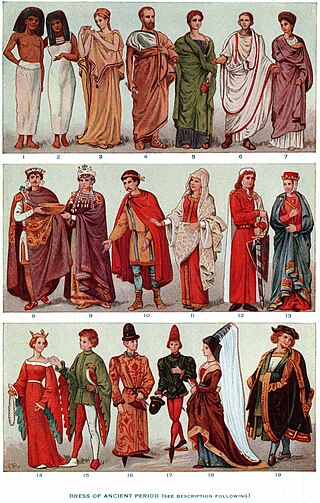
Clothing is any item worn on the body. Typically, clothing is made of fabrics or textiles, but over time it has included garments made from animal skin and other thin sheets of materials and natural products found in the environment, put together. The wearing of clothing is mostly restricted to human beings and is a feature of all human societies. The amount and type of clothing worn depends on gender, body type, social factors, and geographic considerations. Garments cover the body, footwear covers the feet, gloves cover the hands, while hats and headgear cover the head, and underwear covers the private parts.

The Office of Price Administration (OPA) was established within the Office for Emergency Management of the United States government by Executive Order 8875 on August 28, 1941. The functions of the OPA were originally to control money and rents after the outbreak of World War II.

Rationing is the controlled distribution of scarce resources, goods, services, or an artificial restriction of demand. Rationing controls the size of the ration, which is one's allowed portion of the resources being distributed on a particular day or at a particular time. There are many forms of rationing, although rationing by price is most prevalent.

Sir Norman Bishop Hartnell was a leading British fashion designer, best known for his work for the ladies of the royal family. Hartnell gained the Royal Warrant as Dressmaker to Queen Elizabeth in 1940, and Royal Warrant as Dressmaker to Queen Elizabeth II in 1957. Princess Beatrice also wore a dress designed for Queen Elizabeth II by Hartnell for her wedding in 2020.

Used goods, also known as secondhand goods, are any item of personal property offered for sale not as new, including metals in any form except coins that are legal tender, but excluding books, magazines, and postage stamps. Used goods may also be handed down, especially among family or close friends, as a hand-me-down.

Rationing was introduced temporarily by the British government several times during the 20th century, during and immediately after a war.

The term "home front" covers the activities of the civilians in a nation at war. World War II was a total war; homeland military production became vital to both the Allied and Axis powers. Life on the home front during World War II was a significant part of the war effort for all participants and had a major impact on the outcome of the war. Governments became involved with new issues such as rationing, manpower allocation, home defense, evacuation in the face of air raids, and response to occupation by an enemy power. The morale and psychology of the people responded to leadership and propaganda. Typically women were mobilized to an unprecedented degree.
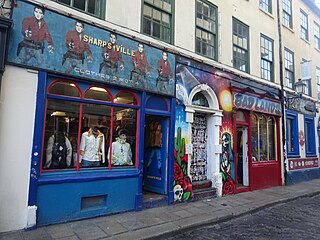
Vintage clothing is a generic term for garments originating from a previous era, as recent as the 1990s. The term can also be applied in reference to second-hand retail outlets, e.g. in vintage clothing store. While the concept originated during World War I as a response to textile shortages, vintage dressing encompasses choosing accessories, mixing vintage garments with new, as well as creating an ensemble of various styles and periods. Vintage clothes typically sell at low prices for high-end name brands.

The most characteristic North American fashion trend from the 1930s to 1945 was attention at the shoulder, with butterfly sleeves and banjo sleeves, and exaggerated shoulder pads for both men and women by the 1940s. The period also saw the first widespread use of man-made fibers, especially rayon for dresses and viscose for linings and lingerie, and synthetic nylon stockings. The zipper became widely used. These essentially U.S. developments were echoed, in varying degrees, in Britain and Europe. Suntans became fashionable in the early 1930s, along with travel to the resorts along the Mediterranean, in the Bahamas, and on the east coast of Florida where one can acquire a tan, leading to new categories of clothes: white dinner jackets for men and beach pajamas, halter tops, and bare midriffs for women.

Fast fashion is the business model of replicating recent catwalk trends and high-fashion designs, mass-producing them at a low cost, and bringing them to retail quickly while demand is at its highest. The term fast fashion is also used generically to describe the products of this business model, particularly clothing and footwear. Retailers who employ the fast fashion strategy include Primark, H&M, Shein, and Zara, all of which have become large multinationals by driving high turnover of inexpensive seasonal and trendy clothing that appeals to fashion-conscious consumers.
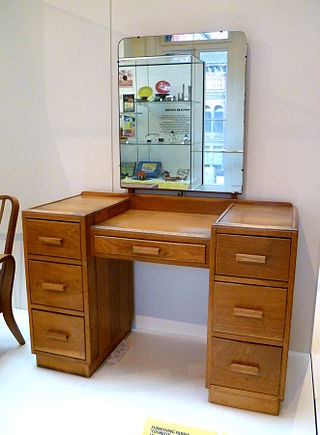
Utility furniture was furniture produced in the United Kingdom during and directly after World War II. The furniture was produced under a government scheme which was designed to cope with raw material shortages and rationing of their usage. Introduced at the end of 1942, the Utility Furniture Scheme continued into post-war austerity and lasted until its abolition in March 1949.

Clothing in ancient Rome generally comprised a short-sleeved or sleeveless, knee-length tunic for men and boys, and a longer, usually sleeved tunic for women and girls. On formal occasions, adult male citizens could wear a woolen toga, draped over their tunic, and married citizen women wore a woolen mantle, known as a palla, over a stola, a simple, long-sleeved, voluminous garment that modestly hung to cover the feet. Clothing, footwear and accoutrements identified gender, status, rank and social class. This was especially apparent in the distinctive, privileged official dress of magistrates, priesthoods and the military.

Sustainable fashion is a term describing efforts within the fashion industry to reduce its environmental impacts, protect workers producing garments and uphold animal welfare. Sustainability in fashion encompasses a wide range of factors, including cutting CO2 emissions, addressing overproduction, reducing pollution and waste, supporting biodiversity and ensuring that garment workers are paid a fair wage and have safe working conditions.

The wedding dress of Princess Elizabeth, was worn at her wedding to Philip Mountbatten, Duke of Edinburgh on 20 November 1947 in Westminster Abbey. Given the rationing of clothing at the time, she still had to purchase the material using ration coupons. The dress was designed by Norman Hartnell. Hartnell's signature was said to be embroidery, and he enjoyed "working with soft, floating fabrics, particularly tulle and chiffon, and with plain, lustrous silks". The dress was made of Chinese silk, with a high neckline, tailored bodice and a short train. Without straps and with long sleeves, it provided a "fit and flare silhouette".

The CC41 symbol, also known as the Utility mark, was an identifying mark of products produced and sold as part of the British Government's Second World War Utility Clothing Scheme.

The Incorporated Society of London Fashion Designers was a membership organisation founded in 1942 to promote the British fashion and textile industry and create luxury couture to sell abroad for the war effort. It aimed to build the relationship between government and fashion industry and represent the interests of London couturiers. The organisation continued after the war and sought to present itself as an alternative to the revived Paris couture industry.
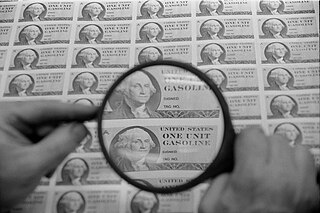
Rationing is the controlled distribution of scarce resources, goods, or services, or an artificial restriction of demand. Rationing controls the size of the ration, which is one person's allotted portion of the resources being distributed on a particular day or at a particular time.

A demob suit was a suit of civilian clothes given to a man on his demobilisation from the British armed forces at the end of the Second World War. Although the suits were of good quality, the need to clothe millions of demobilising servicemen led to supply problems that caused some men to receive suits that were not of the correct size. As a result, the demob suit became a common subject in British comedy in the post-war years.

Community Clothing is a British clothing brand founded in 2016 by Scottish fashion designer Patrick Grant. The company is based in Blackburn, Lancashire, and produces a line of clothing staples using ethically sourced materials, in order to provide consistent employment for a co-operative of British mills and factories and reduce clothing waste.
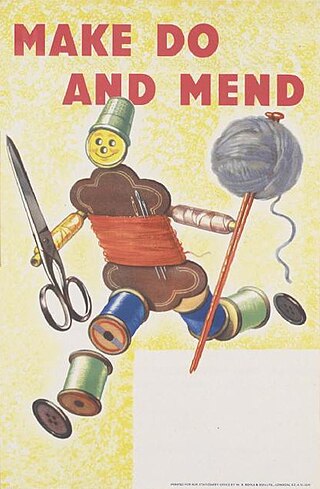
Make Do and Mend was one of several campaigns introduced by the British Government to reduce clothing consumption and save resources during the Second World War. Offering practical guidance on caring for, altering, and mending clothes, instructional pamphlets were produced. In collaboration with voluntary groups, the scheme also offered classes in fibrecraft techniques, such as dressmaking.






















